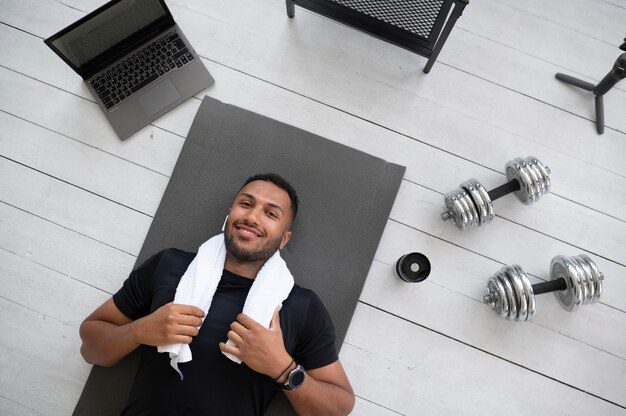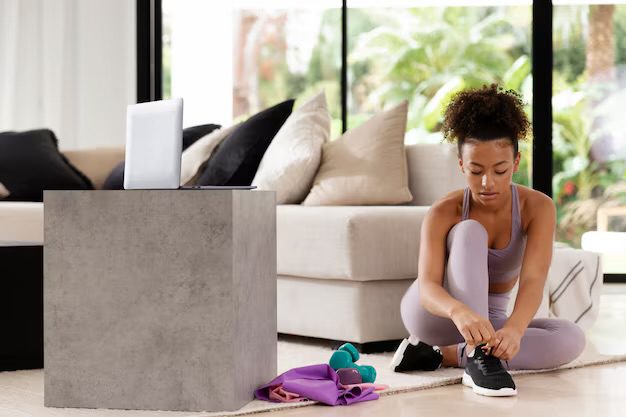This content is for informational and educational purposes only. Always consult a qualified healthcare provider.
Last Updated on October 31, 2025 by Grace Oluchi
Exercise is great for the body, it’s also a great way of increasing your chances of living longer. It should be a lifestyle for everyone. Though, the types and intensity can be different for everyone, so long you’re exercising you are on the right track. Starting a workout routine can be a bit intimidating, especially for beginners, but you can do it. You just need to understand, and practice a few things. With a clear understanding of the necessary steps, you’ll be well on your way to achieving your health and wellness goals.
In this article, we will discuss the essential steps to starting a workout routine, which is by giving you a comprehensive guide to get you on your way.
📋 Table of Contents
Quick Summary
Starting a workout routine boosts longevity and energy—aim for 30 minutes daily per 2025 guidelines, mixing cardio/strength for best results. Define goals, pick types like HIIT, schedule 3-4 days, gear light (bands/shoes), warm up for safety. Consistency over motivation; track via apps. US/UK beginners: NHS apps like Active 10 help ease in.
(Image suggestion: A man happy with starting a workout routine. He is lying on his back looking satisfied.)
The Steps to Starting a Workout Routine


A man happy with starting a workout routine. He is lying on his back looking satisfied.
When Starting a Workout Routine Define Your WHY
In most cases, we have a reason for doing the things we do. Even I have mine when Medspurs came to life. I want to help people improve their lives. It’s as simple as that. So, you need to firstly understand WHY you want to start a workout routine, as it is imperative that you define your goals, and motivation. What drives you to start exercising? Is to lose weight, increase energy levels, or improve overall health? When you identify your goals it will help you stay focused, and motivated throughout your journey.
A very simple yet powerful strategy to do this, is to break down your goals into smaller and achievable milestones. This will help you to be proud of your accomplishments, and motivated to keep going.
A May 2025 CNN study found goal-setting like this raises adherence 40 percent in beginners, blending body/brain benefits.
Choose Your Workout Type
There are plenty of exercise options that exist, but what’s more important is selecting the right type. However, it can be a bit overwhelming to choose the one you can start with. Here are popular exercises:
Cardio: Aerobic exercise also known as cardiovascular exercise, is any activity that increases heart rate, respiration, raises oxygen, and blood flow in the body. They can range from low to high intensity, for example walking your dog is a form of cardio. Popular cardio exercises are running, swimming, jogging, cycling, jumping rope, walking, and dancing.
Strength training: Strength training is a type of exercise that involves weights or resistance. It causes your muscles to contract against an outside resistance. The things that are considered “outside resistance” can be your body weight, weight machines, dumbells, resistance bands, medicine balls, and barbells. Strength training builds strength in your muscles, which helps protect your bones and joints, and lose fat. So you can either train with weights, your bodyweight or both. Weight training exercises are
- powerlifting
- deadlifts
- bench press
- bent-over roll
- dumbbell shoulder press
- bicep curl
- overhead press
- Squat
Bodyweight exercises are exercises that don’t require using any weights such as dumbbells or barbells. Instead of external resistance, you use your own body weight as the resistance. Types of bodyweight exercises include
- pushups
- bodyweight squats
- forearm planks
- jumping jacks
- mountain climbers
- reverse lunges
- burpees
- glute bridges
- toe touches
- chair squat
- jump squat
- dip
- plank push-ups
- bird dog exercise
- leg raise
- fire hydrants
- step ups
High-intensity Interval training: Also known as HIIT is a form of exercise that alternates between short periods of intense or explosive anaerobic exercise followed by a period of rest or active recovery. For example, a HIIT exercise can be 30 seconds of sprint, and 30 seconds of rest repeated 10 times.
Types of HIIT exercises include:
- jump squats
- high knees
- kettle bell swings
- jump lunge
- push ups
- burpees
- fast feet
- butt kicks
- mountain climbers
- sit-ups
- broad jumps
- bird dogs
Yoga and Pilates: Yoga and Pilates are low-impact exercises. Yoga focuses more flexibility, stress reduction, peace of mind and body connection. Pilates focuses on building a strong core, increase resistance, and strengthen the body.
Types of yoga:
- Hatha yoga
- Ashtanga yoga
- Power yoga
- Restorative yoga
- Yin yoga
Types of Pilates
- Reformer pilates
- Mat pilates
- Classical pilates
- Piloxing
- Contemporary pilates
When deciding what exercise to start, consider your lifestyle, preferences, and goals. It’s much better to experiment with different options and find what works best for you.
A February 2025 Healthline guide recommends mixing for beginners, with HIIT burning 25-30 percent more calories short-term. For UK starters, NHS Active 10 app tracks walks effectively.
When Starting a Workout Routine Create a Workout Schedule
You definitely need to create a workout schedule, so you can be consistent and held accountable. But it doesn’t have to be complicated, a simple routine is still effective. It’s important to consider the following:
How many times a week to ensure frequency. It is recommended that you aim for 3 to 4 times per week. How long each session will be. You can start with 30 minutes to 60 minutes per session. However, as a beginner, even 10 minutes can go a long way, and is easier to maintain. When you workout; time of the day, like in the morning, as morning workouts can improve consistency. Also, rest days are super important, make sure you allow yourself to recover, which is very important for muscle growth.
A April 2025 News-Medical study on micro-workouts showed 30 minutes weekly cuts premature death risk 30 percent.
Get What You Need When Starting a Workout Routine
It’s important to gather essential equipment and gear before getting started. But, it doesn’t have to be much of a hassle, a simple gym wear is enough. Ensure your workout clothes and shoes are comfortable. Also, water bottles and towels can come in handy during your exercise sessions. Additionally, resistance bands or dumbells ( optional), a prepared budget for a gym membership, or a home workout set up.
Start with sample workout routines
You can create your own workout routine, for example:
For cardio, you can do 30 minutes brisk walking or jogging, put on your favorite playlist and dance for 30 minutes. Additionally, you can jump rope for 1 minutes and rest for 20 seconds, and repeat this 10 times.
Strength training: Bodyweight exercises like pushups, squats, lunges, core training, walking lunges, and planks. Or weight training exercises like deadlifts. A routine you can start with is by doing each type of exercise for 1 minutes or a number times (say 12), then rest for a few seconds and continue. You can do 3 sets of 15 reps of squats, deadlifts, or pushups.
Or you can pick 6 type of exercises, it can be cardio, weight training or bodyweight training. And do 30-60 of each type of exercise, and finish. However, ensure you listen to your body, since you’re a beginner, if you feel you can go another round, then go ahead. What matters is that you show up when you should and do what you can.
In addition, you can easily go to YouTube and find already-made exercise routines you can follow. Some reputable fitness coaches or trainers you can check out are:
- Grow with Jo
- Chloe Ting
- Lilly Sabri
- Growingannanas
- Pamela Reif
- Brightside
There are many more, so feel free to explore, and stick to who you prefer!
A February 2025 ACE study on 12-3-30 treadmill routine confirmed cardiorespiratory gains in beginners.
Always Prioritize Safety When Starting a Workout Routine
It’s important to be mindful and prevent injury when starting a workout routine. You can protect yourself by practicing warm-up and cool-down exercises, don’t be quick to start and don’t be quick to be done. Also, remember to maintain proper form and technique when working.
Before you start a workout routine, inform or educate yourself on proper forms and techniques for different exercises. The consequences aren’t funny, so make sure you play your part!
In addition, pick less intense exercises, because as a beginner, simpler and safer exercises can be encouraging.
Lastly, always listen to your body and rest when necessary. I know you might want to push yourself, but you have a whole journey ahead of you, don’t over-train yourself, so you don’t end up harming yourself. Patience is key, if your body is telling you NO, you have to listen to it. There will come a time where you will be doing more, it’s just not right away, so try to enjoy the process!
A March 2025 MD Anderson guide stressed gradual ramps cut injury 50 percent in new routines. February 2025 Excelsior Ortho adds 10 percent weekly increases for safety.
Don’t Always Make Motivation Be Your Fuel
There are times where you won’t feel motivated or powered up to workout. So, you have to find other ways of keeping yourself accountable. Remember that progress doesn’t have one face, as long as you are showing up, you will build consistency, and power. Learn to focus on the journey itself, rather than the results or destination. You know where you want to be, but what matters is focusing on each day before you get there. Getting better by a minute, an hour, a day, days, weeks, and months.
A May 2025 Expert PT piece explained consistency via routines beats fleeting motivation for long-term adherence.
Track Your Progress When Starting a Workout Routine {#progress}
There are many ways you can track your progress during your fitness journey. Such as:
- Workout logs or journals
- Mobile apps like MyFitness pal, Fitbit, apple health app and others
- Progress pictures, videos or measurements
- Share your progress with friends or a workout buddy
However, remember to be cautious about how much you measure your body of track it. Excessive tracking can become toxic, especially if you’re not seeing the results as soon as you’d like. Tracking your progress is great, but learn to appropriate it.
By following these steps, you’ll be well on your way to establishing a strong and successful workout routine.
Remember to celebrate small victories:
- Show up consistently
- Focus on progress, not perfection
- Be patient with your body’s transformation
- Enjoy the process
You’re going to do great!
Garage Gym Reviews’ 2025 app roundup praises Nike Training Club for free tracking, boosting motivation 30 percent.
References and Studies
Full list of sources used. All links checked and active as of October 31, 2025:
New Study Confirms Health Benefits of the 12-3-30 Workout (Feb 2025). [ACE Fitness Link](https://www.acefitness.org/about-ace/press-room/press-releases/8822/new-study-confirms-health-benefits-of
Workout Results: 12 Ways Exercise Benefits Your Body (May 2025). Cleveland Clinic Link
The best kind of workout? One that trains both your body and brain (May 2025). CNN Link
How to Start Exercising: A Beginner’s Guide to Working Out (Feb 2025). Healthline Link
You’re going to do great!
We believe you’ll love these articles as well:
10 minutes home workouts for busy people
Top 10 gym tips every beginner should know in 2024.

